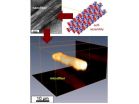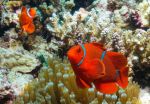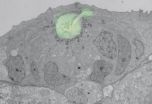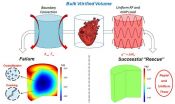Reminiscing can help boost mental performance
2014-10-23
(Press-News.org) ITHACA, N.Y. – To solve a mental puzzle, the brain's executive control network for externally focused, goal-oriented thinking must activate, while the network for internally directed thinking like daydreaming must be turned down to avoid interference – or so we thought.
New research led by Cornell University neuroscientist Nathan Spreng shows for the first time that engaging brain areas linked to so-called "off-task" mental activities (such as mind-wandering and reminiscing) can actually boost performance on some challenging mental tasks. The results advance our understanding of how externally and internally focused neural networks interact to facilitate complex thought, the authors say.
"The prevailing view is that activating brain regions referred to as the default network impairs performance on attention-demanding tasks because this network is associated with behaviors such as mind-wandering," said Spreng. "Our study is the first to demonstrate the opposite – that engaging the default network can also improve performance."
There are plenty of neuroimaging studies showing that default network activation interferes with complex mental tasks – but in most, Spreng explained, the mental processes associated with default network conflict with task goals. If you start thinking about what you did last weekend while taking notes during a lecture, for example, your note-taking and ability to keep up will suffer.
Spreng and his team developed a new approach in which off-task processes such as reminiscing can support rather than conflict with the aims of the experimental task. Their novel task, "famous faces n-back," tests whether accessing long-term memory about famous people, which typically engages default network brain regions, can support short-term memory performance, which typically engages executive control regions.
While undergoing brain scanning, 36 young adults viewed sets of famous and anonymous faces in sequence and were asked to identify whether the current face matched the one presented two faces back. The team found participants were faster and more accurate when matching famous faces than when matching anonymous faces and that this better short-term memory performance was associated with greater activity in the default network. The results show that activity in the default brain regions can support performance on goal-directed tasks when task demands align with processes supported by the default network, the authors say.
"Outside the laboratory, pursuing goals involves processing information filled with personal meaning – knowledge about past experiences, motivations, future plans and social context," Spreng said. "Our study suggests that the default network and executive control networks dynamically interact to facilitate an ongoing dialogue between the pursuit of external goals and internal meaning."
The study, "Goal-congruent default network activity facilitates cognitive control," published in October in the Journal of Neuroscience, was funded in part by the National Institutes of Health and the Natural Sciences and Engineering Research Council of Canada.
INFORMATION:
Cornell University has television, ISDN and dedicated Skype/Google+ Hangout studios available for media interviews. For additional information, see this Cornell Chronicle story.
ELSE PRESS RELEASES FROM THIS DATE:
2014-10-23
Researchers at the New York University Polytechnic School of Engineering have broken new ground in the development of proteins that form specialized fibers used in medicine and nanotechnology. For as long as scientists have been able to create new proteins that are capable of self-assembling into fibers, their work has taken place on the nanoscale. For the first time, this achievement has been realized on the microscale—a leap of magnitude in size that presents significant new opportunities for using engineered protein fibers.
Jin Kim Montclare, an associate professor ...
2014-10-23
In this image taken by the Aqua satellite of the southern United States actively burning areas as detected by MODIS's thermal bands are outlined in red. Each red hot spot is an area where the thermal detectors on the MODIS instrument recognized temperatures higher than background. When accompanied by plumes of smoke, as in this image, such hot spots are diagnostic for fire. These fires are a combination of small wildfires and prescribed fires. On the U.S. Forest Service website a prescribed fire is set to reduce tree overcrowding, revive fire-dependent species and reduce ...
2014-10-23
Despite a dramatic increase in public awareness and anti-bullying legislation nationwide, the prevalence of bullying is still one of the most pressing issues facing our nation's youth, according to a report by researchers from Clemson University and Professional Data Analysts Inc., and published by the Hazelden Foundation.
"Bullying continues to affect a great number of children in all age groups, with the highest prevalence observed in third and fourth grades, where roughly 22 percent of schoolchildren report that they are bullied two or three times or more per month," ...
2014-10-23
A new test, developed by University of British Columbia researchers, could help physicians predict within an hour if a patient will develop severe sepsis so they can begin treatment immediately.
Sepsis, a syndrome caused by infection, leads to organ failure and is responsible for up to five million deaths annually. There are 18 million cases of sepsis worldwide every year.
The discovery could cut back on the lengthy diagnostic time usually required to confirm if a patient is suffering from sepsis and increase the odds that they will respond to treatment.
"We identified ...
2014-10-23
Scientists have found a molecule that could potentially accelerate clinical trials to combat autoimmune diseases.
Researchers from the Australian Regenerative Medicine Institute (ARMI) at Monash University and the European Molecular Biology Laboratory (EMBL) in Italy believe the molecule, called insulin-like growth factor-1 (IGF-1), could play a key role.
Autoimmune diseases occur when a group of immune cells called pro-inflammatory T-effector cells become sensitised to specific cells in the body, identifying them as foreign and attacking them as if they were invading ...
2014-10-23
Sediments associated with dredging and flood plumes could have a significant impact on fish populations by extending the time required for the development of their larvae, according to Australian researchers.
"Sediment concentrations at levels found in plumes from dredging or in floods cause a significant delay in the development of clownfish larvae," says study lead author, Dr Amelia Wenger, from the ARC Centre of Excellence for Coral Reef Studies (Coral CoE) at James Cook University.
"This in turn could significantly reduce the numbers of larvae competent to settle ...
2014-10-23
Loggerhead turtles (Caretta caretta) from Cape Verde start their life with a swimming sprint and a ride on favourable ocean currents. In this way, they escape quickly from predator-rich coastal areas and make their way to the safer open ocean where they spend several years feeding and growing. In this study, tiny acoustic transmitters provided direct insight into these pathways for the first time. "Thanks to the new technology we can start to fill in key information gaps about the so-called 'lost years' Dr. Rebecca Scott states. Funded by the Kiel Cluster of Excellence ...
2014-10-23
From basketball to handball, rugby to American football, teams in a variety of sports huddle together to agree tactics in secret. Cells, too, can huddle to communicate within a restricted group, scientists at the European Molecular Biology Laboratory (EMBL) in Heidelberg, Germany, have found. The study, published today in Nature, is the first demonstration that the way cells organise themselves influences their ability to communicate. The researchers propose that this strategy, which they discovered in developing zebrafish, could be much more widespread, influencing processes ...
2014-10-23
Successful techniques for cryopreserving bulk biomaterials and organ systems would transform current approaches to transplantation and regenerative medicine. However, while vitrified cryopreservation holds great promise, practical application has been limited to smaller systems (cells and thin tissues) due to diffusive heat and mass transfer limitations, which are typically manifested as devitrification and cracking failures during thaw. Here we leverage a clinically proven technology platform, in magnetically heated nanoparticles, to overcome this major hurdle limiting ...
2014-10-23
Narrowband or hyperspectral imaging is a valuable technique used in planetary science for characterizing surfaces and surrounding environments. For example, it can be used to spatially map molecular species of interest on the surface of a solid or icy body, or to sound to different depths in a giant planet atmosphere. However, conducting narrowband or hyperspectral imaging of solar system targets from a balloon-borne platform presents several technical challenges, including mechanical failures and power requirements. These risks can be mitigated with the use of an electronically ...
LAST 30 PRESS RELEASES:
[Press-News.org] Reminiscing can help boost mental performance





